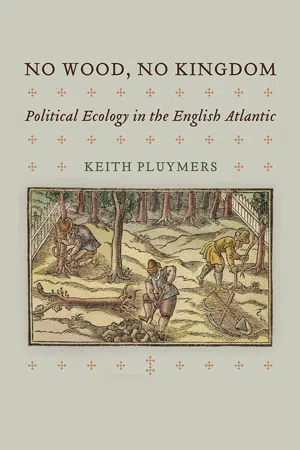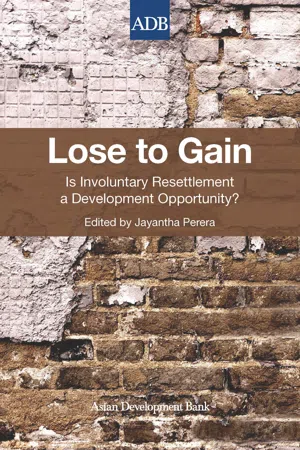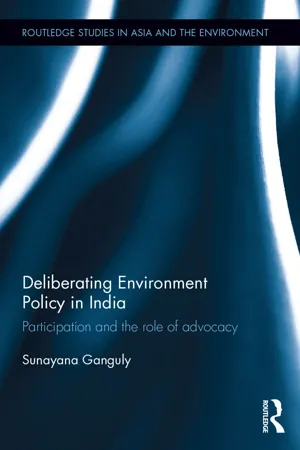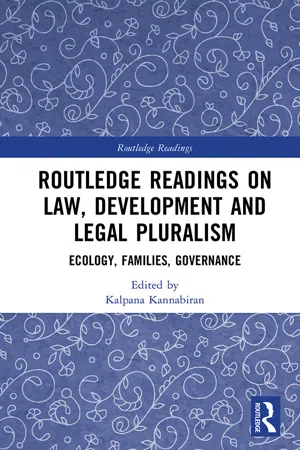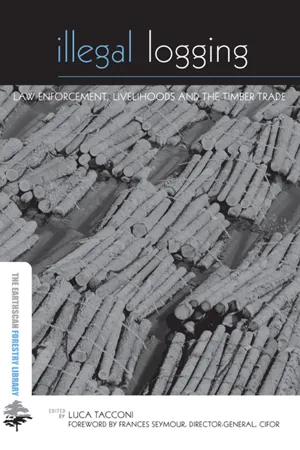History
Forest Laws
Forest Laws were a set of laws introduced in medieval England to protect the forests and their game animals for the king's exclusive use. These laws imposed severe penalties on anyone who hunted, fished, or cut down trees in the forests without the king's permission. The Forest Laws were unpopular and led to widespread resentment and rebellion.
Written by Perlego with AI-assistance
Related key terms
Related key terms
1 of 4
Related key terms
1 of 3
10 Key excerpts on "Forest Laws"
- eBook - ePub
Which Way Forward
People, Forests, and Policymaking in Indonesia
- Carol J. Pierce Colfer(Author)
- 2010(Publication Date)
- Routledge(Publisher)
3 that makes the state the organization with authority over its citizens. These justifications are consistent with previous forest law that has historically been at odds with the agrarian law. The agrarian law allocated private agricultural lands according to the principle that cultivated lands best serve production needs when they are under the control of those managing and using them. This principle is now widely applied in local forest management (Ostrom 1998) and has been one of the driving forces behind devolution policies in other countries (Lynch and Talbott 1995). Furthermore, many customary “forests” are in fact cyclical agricultural and horticultural systems. These lands might have qualified for registration as agricultural land in the 1960s had swidden agriculture then been better understood.A second way in which the new forestry law ensures that the state maintains strategic control is that it gives the state the power to recognize and revoke the status of “customary community,” and therefore of customary forest. This power is vested in local government through regional regulations that remain to be determined and according to criteria determined by national government. According to the new law, the following criteria are used to recognize customary communities:- The community constitutes an association.
- There is a local institution dealing with customary law.
- There is a clear area regulated by customary law.
- Legal judiciary institutions exist, and their decisions are obeyed.
Rights to customary forest are not automatic or in perpetuity in the law. They do not address more deep-seated concerns of customary communities about their rights to a place of ancestral and cultural heritage. They do not provide secure tenure. The rights given in the new law are in this way distinct from those associated with customary communities in other countries, such as the Ancestral Domain Claims in the Philippines or the indigenous comunidades of Mexico.Third, the law states that customary communities’ rights will be given as long as they do not conflict with national priorities. Although the need for flexibility is important, legal provisions such as these have been invoked in the past to limit customary communities’ claims. - eBook - ePub
Law and Society
A Sociological Approach
- James J. Chriss(Author)
- 2019(Publication Date)
- SAGE Publications, Inc(Publisher)
royal forest emerged shortly after the Norman Conquest of the 11th century. Severe punishments (most notably, blinding and mutilation) were imposed against anyone who poached the king’s deer or boar, as well as against those who appropriated timber or grasslands that provided food and cover for these animals (Manning, 1993). Indeed, the forest has continued to be a battleground for law, politics, and policymaking since that time, and we will return to some aspects of the politics of forest policy in the United States later in the chapter.In that Norman Conquest, it was William the Conqueror who introduced to England the concept of foresta, namely, the specification of lands where hunting was permitted (by nobles or select members of the gentry, but typically out of the reach of those lower in social standing), with draconian sanctions levied against violators. By the latter part of the 12th century, the royal forests covered one-third of England. These laws were so contentious that a second set of laws was established after the Magna Carta, the so-called Charter of the Forest (enacted in 1217), which went some way toward the democratization of access to the forests and reducing penalties against those previously barred from participation (Green, 2013). Reflecting this democratization, there was eventually established in England and later Scotland and Wales the practice of offering paid hunting licenses, which were made available to anyone who could afford them (Langton, 2011).However, with the extension of hunting privileges to wider classes of citizens, there were also more formalizations regarding what was permissible in hunts and chases, the latter of which transformed hunting into a game or sport whereby more stringent rules were put into place regarding weaponry, kill limits, and use of dogs to assist tracking and retrieval of game. For example, dogs that were big enough to kill deer were required to have their claws removed, presumably to reduce the chances of such a kill taking place. Additionally, fences or barriers could not be erected for purposes of trapping game. The right to enclose or limit the movement of wild game was restricted to lords of manors (Langton, 2015). - eBook - ePub
An Environmental History of the Middle Ages
The Crucible of Nature
- John Aberth(Author)
- 2012(Publication Date)
- Routledge(Publisher)
A fully fledged administrative structure for the royal forest seems to have emerged at this time, with foresters charged with purview over illegal clearing and cutting of wood, whether for cultivation, firewood, or building timbers, even when taking place on the landowner’s own property. However, at the same time many exemptions were being granted by charter, particularly to monasteries, and the fact that fixed payments were assigned for violations, such that foresters were compensated out of this income, indicates that assarts were being committed on a regular basis. In addition, the fines levied on foresters testify to their sometimes lax enforcement. During the succeeding reign of King Stephen (1135–54), which was wracked by civil war, exemptions to the forest law multiplied exponentially to the point that the law was said to have collapsed or even ceased to exist, as each side sought to win over supporters by such means. 68 The Angevin period of royal forest law inaugurated by King Henry II (1154–89) marked a revival and reorganization of the royal forest, such that it reached the greatest extent it was ever to achieve in its history and acquired its main features of administration that was to last through the succeeding centuries. Perhaps Henry’s single most important act in this regard came towards the end of his reign when he enacted the Assize of Woodstock, sometimes also known as the Assize of the Forest, in 1184. Among its new provisions was that landowners within the royal forest now had to appoint their own foresters or woodwards responsible for upholding the forest law on the king’s behalf within their boundaries, and that a jury of twelve knights was charged in each county with returning offences to the venison and the vert before the forest eyres. In addition, private landowners within the forest had to give securities to the king against harming the woods on their own land and were not to sell or give away wood but could gather it for their own use - eBook - ePub
No Wood, No Kingdom
Political Ecology in the English Atlantic
- Keith Pluymers(Author)
- 2021(Publication Date)
- University of Pennsylvania Press(Publisher)
Long-standing landholders in the forests or at their edges protested loss of commons and threats to their ability to improve their rents by allowing cottagers and other small tenants to settle on marginal lands. Many of the poor protested against the newly detailed examinations of grants and leases that threatened hard-won rights to pasture their animals and collect wood in the forests. These conflicts provide crucial context to understand Charles’s revival of the Forest Laws in the 1630s. Historians have perceived the revival as a desperate act in search of revenue or a moment when Charles’s government decayed into near parody. But placing this action within the context of the long history of conflicting visions about the best uses and management practices for royal forests, demands a more nuanced perspective. The records of the Swainmote Courts convened to hear cases under the Forest Laws from the New Forest show that enforcement frequently targeted forest officials. Crown surveyors Robert and Andrew Treswell received a staggering £2,000 fine for allegedly felling 1,500 oaks and beeches. 101 Almost from the beginning of his reign, Charles had distrusted forest officials. His feelings were not new developments. R. C.’s ignorant and avaricious woodward captured criticisms of forest officials as ignorant, inefficient, and wasteful that had been building since the sixteenth century. Many surveyors and projectors had urged monarchs to curtail the power of forest officials by removing the officers, fining them, or selling lands to private individuals to allow economic incentives to preserve woods without interference from corrupt individuals. Revived Forest Laws provided another way for Charles to undertake his broader program to achieve profitable and renewable forestry that would alleviate scarcity - eBook - ePub
Forests for People
Community Rights and Forest Tenure Reform
- Anne M Larson, Deborah Barry, Ganga Ram Dahal(Authors)
- 2012(Publication Date)
- Routledge(Publisher)
Tribal peoples and other local communities gain little from state territorialization or nationalization of forest control except temporary employment as skilled or unskilled labourers on lands they probably once controlled (Peluso, 1992). Notwithstanding the promise that forest bureaucracies will manage forest resources wisely, their performance in many developing countries has been dismal, perpetuating or even exacerbating land degradation and rural poverty in many countries (Blaikie, 1985).Despite recent efforts to provide new and secure rights to indigenous and other local communities through forest tenure reform, government regulations are still founded on the Euro-American scientific forest management tradition and the bureaucratic culture that has persisted in state forest agencies. As will be revealed in the following discussions of case studies from Asia, Latin America and Africa, forest regulations perpetuate state control over lands and forest resources, undermining the potential benefits of the reform.Forestry regulations and tenure transition: Selected cases
Under new tenure arrangements in community forestry, forest regulations may be enforced through:1 leases or classification systems that limit access to forestland, as in India; 2 conservation-inspired rules that limit activities in protected areas, as in Brazil; and 3 permits, agreements, taxes, management plans and similar requirements that limit access to timber and other valuable forest products, as in the Philippines, Guatemala and Nepal.Regulations that limit access to land6
Despite the recent trend to devolve ownership and/or control of forests to communities, access to high-value forests may be restricted by zoning, classification systems and other land allocation regulations. Such regulations may be viewed as the state’s first line of defence in securing valuable forestlands and limiting the area to be handed back to communities.7 Such regulations may overlay all subsequent decisions, severely limiting community rights.India is one example. As is typical of many Asian countries, India’s forest management has a European legacy, in this case British colonial rule. India was one of the first nations to establish a professional forest service: it nationalized its forest domain under the Forest Act of 1865. Demarcation of uncultivated land under the management of the Indian Forest Service continued over the next century and throughout this period forests were valued mainly for their timber and contribution to the country’s economic development. Tribal communities and other forest dwellers’ resource rights were eroded as the state agencies and the private sector established greater control. Even after independence, much of the British colonial forest policy and administrative system continued to direct the governance of forestland and its resources (Poffenberger, 1996; Poffenberger et al, 1997). - eBook - ePub
Lose to Gain
Is Involuntary Resettlement a Development Opportunity?
- Jayantha Perera(Author)
- 2014(Publication Date)
- Asian Development Bank(Publisher)
But lower courts continue to take the view that municipal law under the statute takes precedence over the rights or privileges that are recognised under customary practices or conventions.” This ambiguity in interpreting the customary rights of forest dwellers and other tribal peoples frequently surfaces in Indian jurisprudence. However, in the following two cases, the Supreme Court has established some firm interpretation of the interests of forest dwellers over forestland and its produce. In Godavarman Thirumulpad vs. Union of India (1997), the Supreme Court liberally interpreted “forest,” establishing a watershed in forest protection and conservation in India. It held that “forest” is not only to be understood in the dictionary sense of the word, but also as any land area designated as forest in government records. It held that the Forest (Conservation) Act of 1980 applies to all forests, irrespective of whether they are public or private and irrespective of the nature of their other classifications. It also held that sawmills and mining are nonforest activities, and prior permission must be obtained from the central government before embarking on such activities. It directed each state government to ensure the cessation of such unapproved activities in forest areas. The Supreme Court imposed on each state government the responsibility to report on the number of sawmills and their capacity, proximity to the nearest forest, and sources of timber. The court also imposed a complete ban on the felling of trees in tropical wet evergreen forests and on the movement of timber with the exception of certified timber required for defense purposes. It ordered each state government to constitute an expert committee to identify forest areas, denuded forests, and areas covered with plantation trees, and to assess the sustainable capacity of forest sawmills. Plantations were barred from further expansion and forests encroachment through clearing or other means - eBook - ePub
Deliberating Environmental Policy in India
Participation and the Role of Advocacy
- Sunayana Ganguly(Author)
- 2015(Publication Date)
- Routledge(Publisher)
gram sabhas do not possess the technical skills to manage and protect forests. The Forest Department has these competencies and thus must retain some control.• The act is primarily based on electoral politics and the regularization of encroachment. • It is “historical injustice” to those communities most dependent on forests for their livelihood to not grant them access to land that is rightfully theirs.• Tribals and other traditional forest dwellers have been left out of the decision-making process in managing the forests despite the overwhelming evidence of deep knowledge of local management practices.• Exclusionary conservation practices have impoverished local communities. • Security of tenure is a key element to involve tribals in forest management. • Rights of these marginalized people have been revoked without any legal due process. • Administrative laxity continues due to state apathy towards such communities.Others pointed out that conservationist research contains a bias towards attributing human harm to ecosystems, even when there is no evidence to support this hypothesis. Rather, evidence has pointed to the contrary. For example when cattle were banned in the Bharatpur national park in 1982, the park’s habitat went on slow decline (Lewis 1995). Examples like these give credence to their views that forests in India have evolved in the context of interaction between humans and biodiversity. Activists have pointed out that forest governance has been shaped in a certain way for hundreds of years without evident benefits, and it is time for a new human-centered approach to conservation. The Forest Rights Act, they argue, is well placed to do this given that there are inherent checks and balances within the act to ensure sustainable practices. For example, three levels (village, sub-divisional and district) of consent are required before any diversion of land. They believed that the FRA could play an important role in making communities true stakeholders of conservation. - eBook - ePub
Not by Timber Alone
Economics And Ecology For Sustaining Tropical Forests
- Peter Ashton, Theodore Panayotou(Authors)
- 2013(Publication Date)
- Island Press(Publisher)
Altogether, a total of 85 million hectares of forest area (or 4.45 percent of the total forest area of the three regions) has been set aside for conservation purposes (Lanly 1982). With the exception of parts of Latin America, little forest has been set aside for protective purposes (water and soil conservation) or for the use of local communities. The primary purpose of Forest Laws has been to establish state property and restrict the access of individuals and communities to the forests. Villagers in the vicinity of the forest are legally prohibited from collecting fuelwood and other non-timber goods, much less harvesting timber from “forest reserves,” “gazetted forests,” or even “production forests.” However, regardless of the legal status of forests, encroachment is often widespread because of both enforcement problems and the lack of alternatives.Whatever their legal status, tropical forests that are largely government owned (80 to 90 percent) are rarely managed. The principal exception is national parks and equivalent reserves (4.4 percent of all forest), where logging is prohibited and intensive management is practiced for the development of recreation, tourism, wildlife, and general conservation. Using the FAO’s definition of intensive management to include control and regulation of logging, protection from fire and disease, and silvicultural treatments, the forests of tropical America generally are not intensively managed. Exceptions include small, managed areas in Trinidad and Tobago and Honduras, and silvicultural trials in Brazil and Peru, which have prepared, but not yet implemented, management plans.Several African countries including Ghana and Zaire have long had management plans that provided for both harvesting regulations and silvicultural treatments, but, except for a brief period in the early 1960s, intensive management has rarely been implemented due to the lack of resources and increasing population pressure. Ghana continues to manage as much as 90 percent of its productive closed forest (1.2 million hectares) and thus accounts for two-thirds of all intensively managed forests of Africa. Uganda (0.44 million hectares) and Kenya (0.07 million hectares) account for most of the remaining third; Cameroon and the Ivory Coast are presently experimenting with intensive management systems. - eBook - ePub
Routledge Readings on Law, Development and Legal Pluralism
Ecology, Families, Governance
- Kalpana Kannabiran(Author)
- 2022(Publication Date)
- Routledge India(Publisher)
Morrison 2015 , p. 43).Fluvial Landscapes and Fluid Lawscapes
Nitin Sinha’s (Chapter 1 ) account of law and agro-ecology in the historical context of diaras in Bihar, contains several very illuminating insights for our understanding of law in practice – in relation to ‘ecological fluidity’, but also in relation to the land question generally. He brings together the concerns of spatial justice in fluvial landscapes, where boundaries between land and water do not lend themselves easily to bureaucratic inscription; where the relationship between codified and customary law, in an important sense, was also the ground of tension between ‘statist’ prerogatives and the inscrutability of ‘local knowledge’; and where the interplay between rights in land, ownership, and occupancy provided the contours of claims to justice. Far from being ‘an abstract institution of rule’, the twists and turns of the law both in its making and in its application – its negotiations and settlements – was demonstration in the everyday of the reconciliations the state was forced to make in terms of governance and policy in specific ecological landscapes. This includes the ‘siting’ of the mobile ‘court’ in these landscapes. This then – the ‘messiness’ between fluid landscapes and legal standardization – serves as a metaphor of legal pluralism that we examine in a separate section.Tribal peoples, adivasis, and forest dwellers live in different states and union territories in India and are spread across the country. Their social, cultural, religious, political, and economic conditions as well as their local knowledge distinguish them from other citizens; their customs, traditions, and livelihoods may differ to varying degrees from other citizens; as far as tribes are concerned, the criteria for the identification of tribes may include but are not restricted to: distinctive lifestyles, customs, livelihood practices, habitations and habitats, culture including language, dialect, and sacral practices. Because of their distance from communities unlike their own, such tribes and forest dwelling communities are particularly vulnerable to exploitation and stereotyping in situations of contact with the world outside theirs, although this contact may historically be frequent and routine. Their status, autonomy, rights, and entitlements are affirmed by the Constitution of India, and by special legislations, importantly the Scheduled Tribes and Other Traditional Forest Dwellers (Recognition of Forest Rights) Act, 2006 - eBook - ePub
Illegal Logging
Law Enforcement, Livelihoods and the Timber Trade
- Luca Tacconi(Author)
- 2012(Publication Date)
- Routledge(Publisher)
6Forest Law Enforcement and Rural Livelihoods
___________________________
David KaimowitzIntroduction
International concern about illegal forestry activities has grown markedly (see Chapter 1 ). There are good reasons for concern. Illegal forestry activities deprive governments of billions of dollars in tax revenues. They also cause environmental damage and threaten forests upon which many people depend. Forest-related corruption and widespread violation of forestry laws undermine the rule of law, discourage legitimate investment, and give the wealthy and powerful unfair advantages due to their contacts and ability to pay large bribes. Money generated from illegal forestry activities has even been used to finance armed conflict.Nonetheless, greater enforcement of forestry and conservation laws also has the potential to negatively affect rural livelihoods. That is because:• Existing legislation often prohibits forestry activities such as small-scale timber production, fuelwood collection and hunting, upon which millions of poor rural households depend.• Most small farmers, indigenous peoples and local communities are ill equipped to do the paperwork required to engage in forestry activities legally or to obtain the technical assistance needed to prepare management plans.• Millions of rural households live on lands that governments have classified as state-owned forestland or protected areas, and existing laws often consider them encroachers even though their families may have lived there for generations.• Forestry and wildlife departments generally enforce forestry and protected area legislation more vigorously and with less respect for due process and human rights when poor people are involved.• In some countries, forestry and wildlife officials engage in illegal activities that harm the poor. Measures that empower these officials and give them more resources can make it easier for them to act with impunity.
Index pages curate the most relevant extracts from our library of academic textbooks. They’ve been created using an in-house natural language model (NLM), each adding context and meaning to key research topics.
Explore more topic indexes
Explore more topic indexes
1 of 6
Explore more topic indexes
1 of 4



